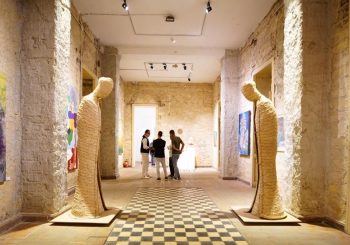With abstract undertones and a seducing presence, Egyptian filmmaker Seif Abdalla and photojournalist Mohamed Mahdy, in their newly released short film ‘Humaithara’, portray the people and religious traditions of Egypt’s remote Humaithara valley.
Humaithara, a town, mountain and valley, located between Marsa Alam and Aswan, is known for its yearly celebration of the Mawlid, or birth, of venerated Sufi Sheikh Abul Hassan Al-Shadhili, who was buried there.
Frederic Brusi, PhD researcher at Stockholm University focusing on Sufism in Upper Egypt and Sudan, spoke to Egyptian Streets about the importance of Humaithara as a site of pilgrimage, “in pre-industrial time, regional and local sites of pilgrimage were very important for Muslims… it’s possible that the practice of pilgrimage outside the hajj is again becoming more popular.”
Brusi recorded some stories of pilgrimage by Muslims from El Qurna in Luxor governorate in 2012 and 2013. Al Shadhili is still considered to be one of the most important saints of Egypt together with Abul Abbas al-Mursi in Alexandria, Ahmad al-Badawi in Tanta, Al-Desoqi in Kafr El-Sheikh Governorate and Abu-l Hajjaj in Luxor.
Every year, nearly half a million people from all over Africa congregate in the valley and celebrate the Mawlid, not only through traditional Sufi rituals but also by standing on Humaithara Mountain at the same time as Muslim pilgrims in Saudi Arabia stand on Mount Arafat during the annual Hajj pilgrimage.
The mountain is considered by Sufi practitioners as a shrine for the late Sheikh al-Shadhili as well as the Qibla, or direction, for their prayers.
Abul Hassan al-Shadhili, born in 1196, was an influential Moroccan Sufi and Islamic scholar who founded what came to be known as the Shadhili order, or tariqa. He was educated in the Moroccan city of Fes and moved to Egypt’s Alexandria in 1244. Brusi explains that
Brusi explains that “many of the local Sufi circles and brotherhoods are either Shazly or branches of Shazly Tariqa [Sufi doctrine or branch].”
“Many of the Egyptian saints are Moroccans who settled in Egypt on their way to Mecca. In Shazly’s, case he actually died on his way to the ferry to Mecca. In my own research in Upper Egypt, one of my informants expressed it thus: ‘The Egyptian heart is a Sufi heart. We love the saints and therefore they love us.”
Brusi further elaborates on the reason why saints who settled in Egypt did so. “They found that the Egyptians’ natural inclination towards mystic traditions fertile soil for their intense love – or Shawq – for the divine.”
He adds, referencing the research of Samuli Schielke and his own, that traditions connected to sanctity, like the Egyptian Mawalid traditions, are very easy points of access to the divine realm for the people.
“To participate in zikr [remembrance of Allah] or just to go to the mawlid to have fun for a few hours, is easy compared to the more demanding plights of Salafism, which generally regard mawlid as unIslamic practice. The mawlid becomes a time and place where the sacred and the profane coincides,” adds Brusi.
Abul Hassan al-Shadhili’s spiritual knowledge had become particularly influential in Tunisia and Egypt, where he died in 1258 on his way to Mecca.







Comment (1)
[…] major annual observance, to the “poor man’s Hajj” in the Eastern Desert’s remote Humaithara Valley, where hundreds of thousands of worshippers congregate each year for the moulid of the 13th-century […]